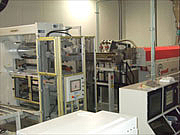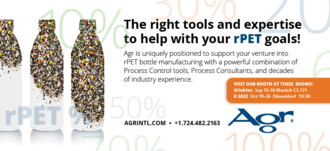| Davis-Standard, LLC and Gneuss, Inc., headquartered in Germany, recently joined forces to supply a unique non-dried PET sheet system that combines high outputs with cost-saving technology. The first of its kind in the U.S., this system merges Davis-Standard engineering and project management with a patented Multi Rotation System (MRS) from Gneuss. Processing rates of 2,000 pounds (900 kg) per hour for PET thermoformed sheet can be achieved while reducing overhead costs associated with similar non-vented extrusion processes. |
Background
The conventional method for processing PET, post consumer or industrial flake is via a single screw extruder. Using this method, moisture and volatiles must be removed first to avoid breakdown of the polymer chain during the melt phase of the process. This requires the feedstock to be crystallized so it can withstand elevated drying temperatures. The crystallizing, drying, and time involved is costly, requiring more energy, equipment and plant space for the finished product.
The technology offered by Davis-Standard and Gneuss streamlines this process. On the Davis-Standard system, a blender combines the PET, post consumer or industrial flake with virgin pellet flake from each component’s blender hopper in one step, eliminating the crystallizing and drying processes. Once blended, the resin is vacuum conveyed to the feed throat of the MRS extruder for processing.
MRS Technology
The design of the MRS extruder is comparable to the vent section of a single or twin screw extruder where degassing of the melt stream occurs under precise vacuum control. However, the degassing section of the MRS is much larger, surpassing the surface exchange of a twin screw by 25 times and a single screw by 50 times. This makes it possible to remove moisture and volatiles in the melt stream even more efficiently. The degassing properties of the MRS are also effective when used with a moderate vacuum level, enabling processors to use less expensive and easier to maintain vacuum equipment. Other advantages include low shear stress and thermal stress for melt, excellent pressure build-up (eliminating the need for a gear pump in some applications), low energy consumption and a compact design. The result is high quality sheet and a process that saves time and money. In addition, when processing post consumer reclaim the degassing section provides excellent decontamination of the material. FDA approval for processing PET bottle flakes is pending.
Davis-Standard Advantage
All extrusion technology for this system was supplied under the watchful eye of Davis-Standard. This included everything from the blender loader hopper, Gneuss’s fully-automatic RSFgenius melt stream filter and in-line viscometer, to the die and the on-line X-ray gauging system, to the roll stand and winder. Key components included Davis-Standard’s EPIC control system with closed loop capability; a roll stand with independent roll speed control; and a turret winder for 48-inch diameter rolls weighing over 5,000 pounds (2,200 kg). Davis-Standard engineered the system so that the finished sheet is fed directly into the secondary operation where it is thermoformed into translucent trays used for fresh food items such as strawberries and tomatoes.
| Davis-Standard sheet systems: Al Chrisbacher achrisbacher@davis-standard.com | Gneuss: www.gneuss.com |







